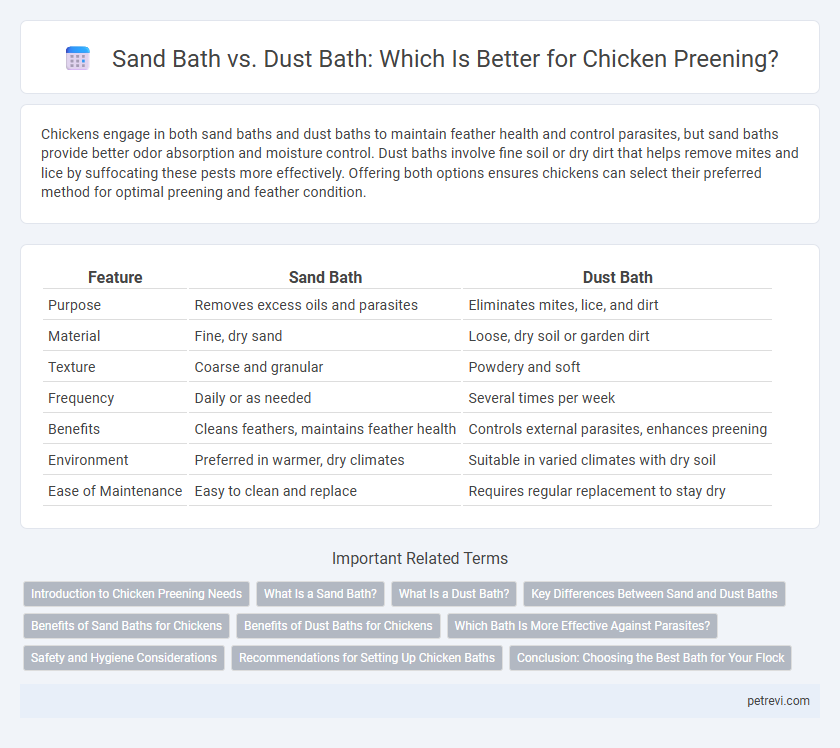Chickens engage in both sand baths and dust baths to maintain feather health and control parasites, but sand baths provide better odor absorption and moisture control. Dust baths involve fine soil or dry dirt that helps remove mites and lice by suffocating these pests more effectively. Offering both options ensures chickens can select their preferred method for optimal preening and feather condition.
Table of Comparison
| Feature | Sand Bath | Dust Bath |
|---|---|---|
| Purpose | Removes excess oils and parasites | Eliminates mites, lice, and dirt |
| Material | Fine, dry sand | Loose, dry soil or garden dirt |
| Texture | Coarse and granular | Powdery and soft |
| Frequency | Daily or as needed | Several times per week |
| Benefits | Cleans feathers, maintains feather health | Controls external parasites, enhances preening |
| Environment | Preferred in warmer, dry climates | Suitable in varied climates with dry soil |
| Ease of Maintenance | Easy to clean and replace | Requires regular replacement to stay dry |
Introduction to Chicken Preening Needs
Chicken preening is essential for maintaining feather health, skin condition, and parasite control, with sand baths and dust baths serving distinct purposes. Dust baths help remove excess oils and deter external parasites like mites and lice by coating feathers with fine particles. Sand baths aid in loosening dirt and can soothe irritated skin, promoting overall comfort and cleanliness during preening.
What Is a Sand Bath?
A sand bath is a natural method chickens use for preening, involving rolling and fluffing their feathers in fine, clean sand to remove excess oils, parasites, and dirt. The abrasive texture of sand reaches deep into feathers, helping to dislodge mites and other pests while maintaining feather health. This behavior promotes natural grooming and enhances feather condition without the moisture associated with dust baths.
What Is a Dust Bath?
A dust bath is a natural behavior in chickens where they roll and flap in loose, dry soil or fine particulate matter to clean their feathers and skin by removing excess oil, parasites, and dead skin cells. This activity promotes healthy preening by allowing particles to absorb moisture and dislodge external pests like mites and lice from their plumage. Unlike sand baths, which use coarser grains, dust baths require fine, dry dust to effectively maintain feather condition and overall poultry health.
Key Differences Between Sand and Dust Baths
Sand baths for chickens primarily involve fine grains that help in loosening and removing external parasites through abrasion, while dust baths use fine, dry soil or volcanic ash to absorb excess oils and moisture from feathers. Sand offers better weight and texture for effective exfoliation, whereas dust is lighter and more easily inhaled, requiring well-ventilated environments to ensure chicken health. Both methods are essential for preening, but sand baths tend to be more durable and provide enhanced parasite control compared to dust baths.
Benefits of Sand Baths for Chickens
Sand baths for chickens provide effective parasite control by allowing birds to dislodge mites and lice through abrasive action. The fine texture of sand absorbs excess oil and moisture from feathers, promoting healthier skin and plumage. Compared to dust baths, sand baths minimize respiratory irritation and enhance overall cleanliness, supporting better preening habits.
Benefits of Dust Baths for Chickens
Dust baths provide chickens with a natural method to remove parasites such as mites and lice, promoting healthier skin and feathers. The fine particles in dust penetrate feathers and skin, helping to absorb excess oils and moisture while reducing the buildup of harmful bacteria. This behavior enhances chickens' overall well-being by supporting natural preening and maintaining optimal feather condition.
Which Bath Is More Effective Against Parasites?
Dust baths are generally more effective against external parasites in chickens, as the fine particles penetrate feathers and skin to dislodge mites and lice. Sand baths can assist in preening by helping chickens maintain feather cleanliness, but sand's larger grain size may not reach parasites as efficiently as the finer dust. Incorporating a mix of dry soil and organic materials in dust baths enhances parasite control by ensuring deeper cleansing action.
Safety and Hygiene Considerations
Sand baths provide chickens with fine particles that help remove parasites while maintaining better hygiene due to sand's quick drainage and lower moisture retention. Dust baths, often composed of dry soil or wood ash, can effectively control mites but may present higher risks of bacterial growth if the material retains moisture or is not regularly replaced. Ensuring clean, dry substrates and frequent maintenance is essential in both methods to promote safe and hygienic preening environments for chickens.
Recommendations for Setting Up Chicken Baths
For optimal chicken preening, setting up a dust bath with fine, dry soil and sand mixed with wood ash is recommended to effectively remove parasites and excess oil from feathers. A sand bath, primarily composed of clean, coarse sand, supports similar benefits by allowing chickens to dig and flap, promoting natural grooming behaviors. Place baths in dry, sunny areas with good drainage to prevent moisture buildup and maintain hygiene, replenishing substrate regularly to ensure cleanliness and effectiveness.
Conclusion: Choosing the Best Bath for Your Flock
Dust baths provide chickens with fine particles that effectively remove parasites and excess oils from feathers, promoting healthier skin and plumage. Sand baths offer similar benefits but tend to be coarser, making them better suited for larger breeds requiring deeper cleaning. Selecting the best bath depends on flock size and breed, with dust baths generally preferred for smaller flocks and delicate breeds, while sand baths support robust grooming in heavier birds.
Sand Bath vs Dust Bath for Chicken Preening Infographic

 petrevi.com
petrevi.com